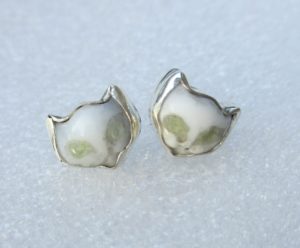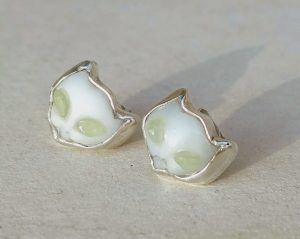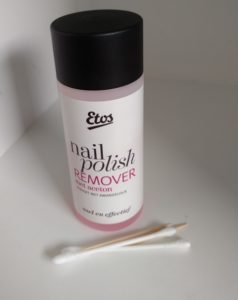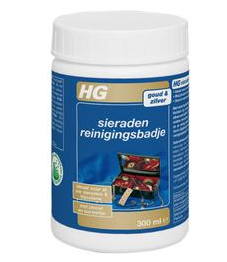Jewelry hygiene is important
In my previous weblog post I wrote proudly that I can act as my own model. Then someone told me that pictures with people wearing necklaces and earrings might give the customer an idea that the piece has been worn and is ‘not clean’. Somehow it does not apply to rings. Seemingly the buyers accept the fact that they see the ring worn on a hand. But necklace and earrings… maybe they are much too close and personal?
Anyway, jewelry is a personal wearable object. Jewelry hygiene is important. As the hobby jeweler often does not have professional cleaning equipment, we have to rely on home remedies. Very much the same which the wearer has. So we can share some tips with the wearer, who can use them too. This is why I write this post.

Jewelry hygiene I: cleaning after polishing
Polishing leaves a stain on the jewelry piece. Some polishing pastes are quite a bit greasy. Dirt also comes from the wearing off of the polishing disks, sanding paper etc. The dirt can be well seen on white, clear stones and high polished silver. Sometimes I see it only when I have made a high-resolution picture and zoomed it to 100%. It means the piece can be seen 10-20 times larger than in real life. The problem is that it is also seen by the webshop visitors. Who rarely see it 20 times as large, because during wear it is not noticeable. Yet there IS grease and dirt. And it diminishes the shine of the stone. Unnoticeable does not mean it can’t be seen.

How to clean? At this stage, you can use different chemicals for cleaning. For instance, I bleached the white stones in these cat earrings with household chlorine. Be extremely careful! Chlorine is damaging many materials, like silver. The chlorine that is in pools or even in your hot tub can cause the silver to react. This will cause a greenish discoloration on the metals making them very hard to clean. The colored stones might dislike bleaching too. The only material that can stand it well is white quartz. Just like porcelain of the toilet pot. Excuse my comparison.
You can boil the piece – in clean water or with a pickling chemical. Most of the jewelry materials can stand the temperature of 100 degrees Celsius. I would not recommend pickling with soft stones or pearls. But boiling is possible. Even pearls survive this temperature.
Then you just rinse with warm water and toothbrush. A dedicated (electric) toothbrush (head) is just fine. Some jewelers even use toothpaste or powder. But mild – if necessary – antibacterial – soap is fine too.
Jewelry hygiene II: Cleaning before shipment

This step shall never be skipped! As I said before, zoomed in pictures let see many things which went unnoticed previously. Besides that, the pieces have been (test) worn on a model. After test-wearing all these pieces must be meticulously cleaned. Though silver is considered to be antimicrobial, every time a piece has been test-worn it should be disinfected at least with alcohol or anti-microbial gel. Leather necklaces are never test-worn since they can not be cleaned properly. This is why I wear my own chains when modeling.
So how to clean the jewel before you send it to the buyer? In some cases, final polishing is done. Then see step one above. If there are glued elements, like pearls which are usually glued, be careful with water. Just rinsing is okay, but not soaking or boiling. I often use a nail polish remover (without oil or other additives) to remove glue, dirt, grease etc. Apply it strictly topically with an ear cotton stick or even a wooden toothpick. The problem is that cotton fiber remains or may get stuck in prongs. So inspect the piece thoroughly before shipping it. Make another HD photo.
For leather, I learned that dirt or grease can be best removed with facial cleansers. That makes sense. Leather is just skin. Excuse my comparison.
Jewelry hygiene III: Cleaning during wear
Now comes the most interesting topic – for the wearer. All household chemicals mentioned (with the exception of the chlorine, I would not experiment with it) can also be used for cleaning jewelry during wear. Nail polish remover, alcohol, ammonia solution, even benzine for metal washing are mostly used for metal and stone degreasing. They don’t leave any traces. Though they smell for a while.
Be still careful with stones like opal. Make sure stones are not glued in. Most transparent stones are ok but some opaque gems may have treatments which might be affected by the solvent action. You are probably safer with a brush and regular jewelry cleaning solution. There are many brands on the market. In the Netherlands, you can even buy them in a supermarket. There is the HG brand which is quite effective. If there are no commercial solutions available you can always try household remedies. Here are some of them.
Alcohol and ammonia
* If cleaning gold and gemstones, first soak in an isopropyl alcohol for several hours.
* Allow this process to remove grease from the jewelry.
* Rinse thoroughly.
* Use a jewelry style cleaning solution, consisting of a solution of ammonia (1/2 cup) and water (2 cups).
* Use a soft-bristled toothbrush to work the cleaning solution into the gems and cracks and crevasses of the gold or silver.
* Make sure to turn around the piece in all directions to get into all grooves.
* You can also use any other small sized, soft brush, such as a nail brush to do this.
* Do not use anything that is abrasive as gold and silver can be scratched.
* Rinse the jewelry thoroughly in warm to cool water.
* Allow to air dry.
* You can polish it with a clean terry cloth for a bit more shine.
Baking soda and vinegar
To remove built-up tarnish from your silver, make a thick paste with 1/4 cup baking soda and 2 tablespoons water. Apply with a damp sponge and gently rub, rinse, and buff dry. To polish gold jewelry, cover with a light coating of baking soda, pour a bit of vinegar over it and rinse clean. Note: Do not use this technique with jewelry containing pearls or gem-stones, as it could damage their finish or loosen any glue.
Take care with pearls. As pearls are very delicate and you will want to take special precautions to make sure that you clean them appropriately. Even hairspray and perfume can damage their delicate surface.
If they become dirty, just wipe them with a damp cloth. You can polish your pearls with a little drop of olive oil to keep their luster. Rinse them very well and dry. Never use detergent, ammonia or alcohol, or any commercial cleaner not specifically made for pearls at it may damage them.
More tips how to clean jewelry at home
max zelin
“Excuse my comparison.” I had to laugh. Thank you for this article.